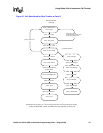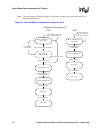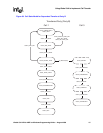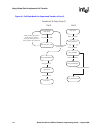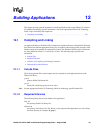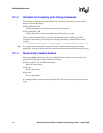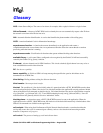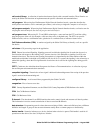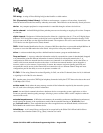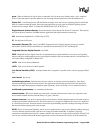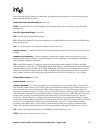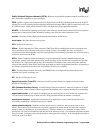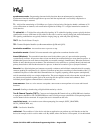
Global Call API for HMP on Windows Programming Guide — August 2006 143
Glossary
ASO: Alarm Source Object. The source of an alarm, for example, either a physical alarm or a logical alarm.
ANI-on-Demand: A feature of AT&T ISDN service whereby the user can automatically request caller ID from
the network even when caller ID does not exist.
ANI: Automatic Number Identification. A service that identifies the phone number of the calling party.
ASCII: American Standard Code for Information Interchange.
asynchronous function: A function that returns immediately to the application and returns a
completion/termination at some future time. An asynchronous function allows the current thread to continue
processing while the function is running.
asynchronous mode: Classification for functions that operate without blocking other functions.
available library: A call control library configured to be recognized by the Global Call API and successfully
started by the Global Call gc_Start( ) function.
B channel: A bearer channel used in ISDN interfaces. This circuit-switched, digital channel can carry voice or
data at 64,000 bits/second in either direction
BC: See bearer capability.
bearer capability: A field in an ISDN call setup message that specifies the speed at which data can be
transmitted over an ISDN line.
blind dialing: Dialing without waiting for dial tone detection.
blind transfer: See unsupervised transfer.
blocked: The condition of a line device initially when it is opened and after a GCEV_BLOCKED event has been
received on that line device. When a line device is in a blocked condition, the application can only perform a limited
subset of the Global Call commands on that line device. Call related functions may not be called with the exception
of gc_DropCall( ), gc_ReleaseCall( ) (E1, T1 and ISDN technologies only) and gc_ReleaseCallEx( ). Non-call
related functions are generally allowed. See also “unblocked” below.
blocking alarm: An alarm that causes a GCEV_BLOCKED event to be sent to the application. When the
application receives a GCEV_BLOCKED event, the line device is blocked which means only a limited subset of the
Global Call commands are available to the application.
call analysis: When using Intel NetStructure
®
Digital Network Interface boards, a term that describes the
activity that occurs after a call is connected (post-connect), such as voice detection and answering machine
detection. Compare to call progress.
call control: The process of setting up a call and call tear-down.



